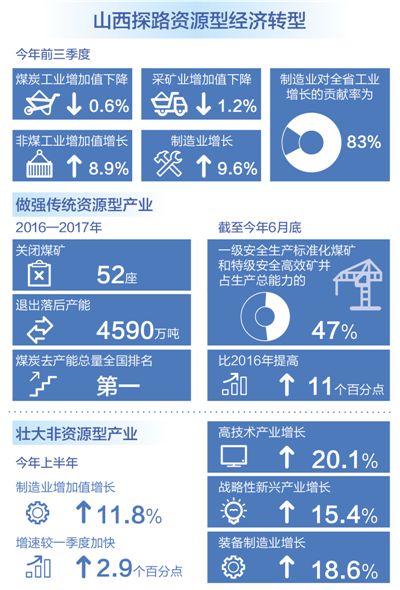14
2018
-
11
Coal Shanxi's transformation can be expected
分(fēn)类:
Industry News

Drawing: Guo Xiang
In the first three quarters of this year, the added value of the coal industry in Shanxi fell by 0.6%, and the added value of the non-coal industry increased by 8.9%; the added value of the mining industry fell by 1.2%, and the manufacturing industry increased by 9.6%. The contribution rate of manufacturing to the province's industrial growth was 83%, leading the growth of Shanxi's industry. At the same time, the tax revenue of the non-coal industry was 73.59 billion yuan, a year-on-year increase of 24.2%, accounting for 54% of tax revenue, which became an important support for the rapid growth of tax revenue this year.
It can be seen that, compared with the current coal market, the pillar of Shanxi's resource-based economy-the coal industry is not "bright" or even "dark". And behind this "dark" data is the progress that Shanxi has made on the road to resource-based economic transformation.
For a long time, many typical "disadvantages" of resource-based economy, such as the simplification of leading industries, irrational economic structure, and high dependence on resources, have been reflected in Shanxi. Shanxi has been actively seeking ways to achieve economic transformation...
Reduce production capacity, optimize structure, and renew the engine for traditional industries
Lu'an Group Shigejie Coal Mine is the first coal mine regained by the Shanxi-Hebei-Shandong-Henan Border Region government. It has a 90-year mining history. It was once famous in the coal industry for its “Shigejie Spirit” of “hard work and thrift operation”. Now the well head has been closed by concrete, and the sign stone beside it is clearly engraved with "closing time". This time scale marks the end of a glorious history and a better future.
This "meritorious" coal mine is one of the 52 coal mines in Shanxi that have been shut down and withdrawn from overcapacity reduction in the past two years. It is also a testament to Shanxi's determination to reduce production capacity, take the lead in reducing production capacity, and promote supply-side structural reform.
For a long time, the deformed industrial structure of "one coal dominates" has made Shanxi's economy a "roller coaster" with the rise and fall of coal prices. The problems in the industrial structure have reached a consensus across the province, but the determination to solve the problems has retreated with the fluctuation of coal prices, and the problem has not been fundamentally solved.
The supply-side structural reform proposed by the central government provides opportunities for Shanxi to reduce production capacity and adjust structure. Shanxi introduced and implemented "five batches" (eliminate a batch, reorganize a batch, withdraw a batch, reduce a batch, postpone a batch) and other overcapacity measures at the right time, shut down and withdraw from severe disasters, exhaustion of resources, and no safe production Coal mines that do not comply with the coal industry policy should resolve excess production capacity.
With the process of reducing production capacity, the relationship between supply and demand has changed, and coal prices have been rising all the way, and Shanxi has always maintained its "fixed force." From 2016 to 2017, Shanxi Province closed 52 coal mines and withdrew 45.9 million tons of outdated production capacity. The total amount of coal decapacity was ranked first in the country. The excess capacity and quality preservation completed the tasks assigned by the state, and formed a coal depot in practice. "Shanxi experience" of production capacity.
“Subtract” outdated production capacity to make room for development; “Add” to advanced production capacity to promote the conversion of new and old kinetic energy. Shanxi promotes the construction of safe, efficient and standardized mines, and has identified a batch of provincial and municipal pilot coal mines to provide reproducible, referenceable and extendable empirical practices for the full implementation of the new standardization of coal mine construction. As of the end of June this year, the province's first-level safety production standardized coal mines and super safety and high-efficiency mines accounted for 47% of the total production capacity, an increase of 11 percentage points from 2016, promoting the adjustment, optimization and upgrading of the coal industry in Shanxi.
In addition to the coal industry, Shanxi is also optimizing and transforming the three resource-based industries such as "electricity", "coking" and "smelting" to achieve green upgrades and allow traditional industries to "new branches" from old trees.
In 2017, Shanxi eliminated 561,000 kilowatts of outdated coal-fired power generating units, accounting for 10% of the country’s total elimination of coal-fired power generating units; reduced the outdated steel production capacity by 3.25 million tons, and cleared all the production capacity of “floor steel”, and the output of low-end products was obvious Decline, the output of high-end products continues to rise.
"The transformation of a resource-based economy is not about'despising' resource-based industries, but more attention is paid to the structural adjustment and upgrading of resource-based industries, and the improvement and strengthening of traditional resource-based industries." Shuozhou City Party Secretary Chen Zhenliang said when talking about the transformation of resource-based economy: Let it provide better and newer momentum for the transformation of the resource-based economy."
Take a high look at the non-coal industry to strengthen the new momentum of economic transformation
For a long time, the resource-based industries with coal as the core in Shanxi are almost "covering the sky with only one hand." If they cannot cultivate and expand new non-coal industries and provide new impetus for economic development, the transformation of the resource-based economy will not succeed.
According to expert analysis, the "dependence" of the formation of a resource-based economy is conducive to the development of resource-based industries, but it has a "crowding out" effect on other non-resource-based industries, restricting their growth and expansion. To get rid of this "crowding out" effect and to play a decisive role in the market, the government needs to be aggressive and hardworking.
"Since 2018, the proportion of non-coal industry's industrial added value in the regulated industrial added value will increase by at least 2 percentage points each year, and the proportion of the coal industry's added value will be reduced accordingly, and the proportion of non-coal industry's added value in the regulated industrial added value will be 28% from the current Increase to more than 50% in 2030." As the only growth resource city in Shanxi designated by the State Council-Shuozhou, this sentence was included in the plenary report. This decrease by one increase reflects the "take a high look" on the non-coal industry, and also reflects the determination and attitude to promote the transformation of the resource-based economy.
In Changzhi City, it only took 42 days for a project to go from signing to production, and the whole process "run" at an amazing speed. Behind this speed is a set of "addition and subtraction": pre-approval items are reduced from 6 to 4, corporate commitments are reduced from 12 to 5, and government unified service items are increased from 3 to 10.
The pros and cons of the business environment are the basic conditions for the prosperity of the industry. Shanxi optimizes and reengineers its processes to create a business environment with "the least approval, the best process, the most smooth system, the most active mechanism, the highest efficiency, and the best service", providing fertile "soil" for the development and growth of emerging industries.
At the same time, Shanxi has formulated a strategic emerging industry development plan to "set the top" in accelerating the cultivation and development of emerging industries, and prioritize the development of strategic emerging industries represented by high-end equipment manufacturing, new energy, new materials, new energy vehicles, etc. The industrial structure is a new driving force for the transformation of the resource-based economy.
In Yangquan City, Baidu's Yangquan Data Center has more than 160,000 servers designed and installed, making it one of the largest cloud computing data centers in Asia. What's more valuable is that green energy such as wind and solar energy is widely used in the power supply of data centers, which is called "green" data centers on coal piles.
Shanxi formulated the development plan for the characteristic industry of big data, formed the Shanxi Artificial Intelligence Industry Alliance, cultivated three characteristic industries of information security, sensors, and artificial intelligence, and promoted Lv Lianghua’s Shanxi Big Data Center, Shanxi Beidou Data Center, and China Electronics Technology Innovation Industrial Park. Project construction, to create a digital industry cluster with Shanxi characteristics.
In the first half of this year, among the designated industries in Shanxi Province, the added value of the manufacturing industry increased by 11.8%, an increase of 2.9 percentage points higher than that in the first quarter. High-tech industries, strategic emerging industries, and equipment manufacturing grew by 20.1%, 15.4%, and 18.6% respectively, which can be described as "rapid" growth.
"Reduce, optimize and green" promote the energy revolution and help the energy industry get rid of coal dependence
Experts believe that Shanxi's energy industry is represented by coal power, which accounts for a high proportion and heavy weight in the industrial structure, and is heavily dependent on coal resources. This is also the crux of the resource-based economic structure of Shanxi. "Through the adjustment and upgrading of the energy industry, reducing or even getting rid of dependence on coal is an extremely important part of the transformation of the resource-based economy."
Shanxi uses the “energy revolution” as its starting point to “reduce” coal from both ends of energy supply and consumption: By 2020, Shanxi’s coal production will be “controlled within 1 billion tons” as previously stated, and changed to “basically stable at 9. In terms of power installed capacity, Shanxi’s coal power installed capacity target will be reduced from 92 million kilowatts to 72 million kilowatts by 2020; in terms of energy consumption, Shanxi’s total energy consumption control target will be reduced from 227 million tons by 2020 Standard coal, reduced to 224 million tons of standard coal.
In the first quarter of this year, Shanxi's investment in new energy power generation increased by 95.2%, while thermal power investment decreased by 29.1%; the total investment in new energy power generation was 2.2 times that of thermal power investment. As of the end of June 2018, Shanxi's new energy installed capacity reached 23.47 million kilowatts, which accounted for 28.5% of the province's installed electricity capacity, optimizing the energy supply structure and reducing its dependence on coal.
Cao Haixia, director of the Research Office of the Energy Research Institute of Shanxi Academy of Social Sciences, believes that energy supply and consumption revolution need the support of energy technology and system revolution. Energy technology and system revolution promote the improvement of energy supply and consumption revolution. The "four revolutions" are mutually exclusive. Linkage and mutual promotion are focused on improving linkage and interaction efficiency and quality.
In Datong, known as the "Coal City", the Alliance for the Transformation of Scientific and Technological Achievements of Chinese Academy of Sciences and 10 Institutes of the Chinese Academy of Sciences jointly registered the Institute of New Energy Industry Technology of the Chinese Academy of Sciences, the Chinese Academy of Engineering, and the European Academy of Sciences. The new energy industry strategy advisory committee, formed with top scientists in the energy field such as the Academy of Art, strives to promote the energy technology revolution. At present, the top ten breakthrough projects of the energy revolution in Datong city around hydrogen energy, solar energy, wind energy and other aspects are rapidly advancing and progressing smoothly.
"Datong must promote energy supply, consumption, technology, and institutional revolutions as a whole and efficiently, and then create a green and diversified modern energy industry system that does not rely on coal." Datong Mayor Wu Hongwen said: "Our energy products are not Then there are simple coal or electricity converted from coal, and more advanced clean energy, energy equipment, and even industrial technology standards."
In 2017, Shanxi's investment in the traditional industries of coal, coking, smelting, and electricity fell by 9.8%, while investment in non-traditional industries increased by 22.9%. In the first quarter of this year, investment in the mining industry fell by 6 percentage points, while investment in manufacturing and high-tech industries increased by 12.7% and 17.2, respectively. %.
The intensity of changes in industrial investment data confirms the strength and effect of the upgrading of Shanxi's industrial structure. However, the contradictions of Shanxi's resource-based economic structure have a long history and deep accumulation, and it is not a day's effort to resolve them. It requires continuous effort and long-term success to take the path of resource-based economic transformation step by step.
This article is transferred from China Coal News Network
More company information
Welcome to pay attention to [Jingji Technology Co., Ltd.] WeChat public account


相关新(xīn)闻

